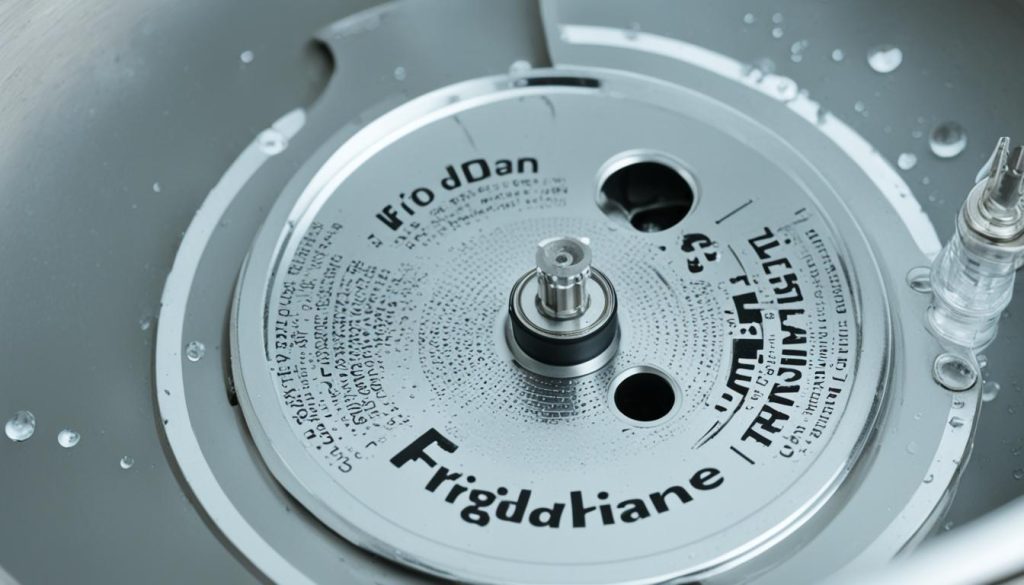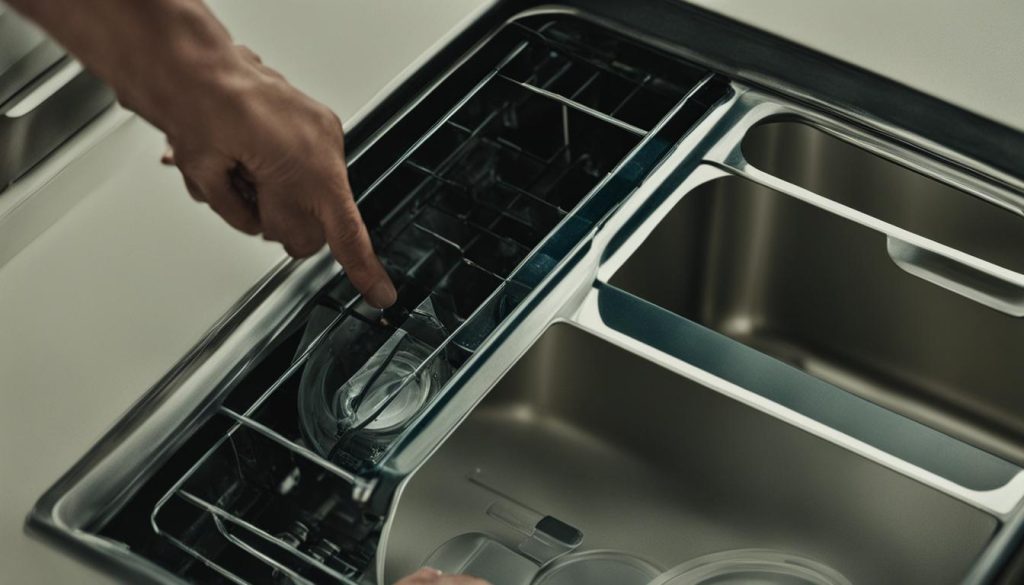Frigidaire Dishwasher Not Draining Solutions
If you think a clogged drain is just a minor inconvenience, think again. Did you know that a Frigidaire dishwasher not draining water properly can waste up to 2,500 gallons of water per year? That’s enough water to fill a small swimming pool!
If you’re experiencing this frustrating issue, don’t worry. In this article, I will guide you through some common causes for a Frigidaire dishwasher not draining and provide effective solutions to get your dishwasher back in working order. Whether it’s a dirty filter, a blocked drain hose, a malfunctioning drain pump, or problems with the air gap or garbage disposal, we’ve got you covered.
Key Takeaways:
- A Frigidaire dishwasher not draining can waste up to 2,500 gallons of water per year.
- Common causes include a dirty filter, a blocked drain hose, a malfunctioning drain pump, or issues with the air gap or garbage disposal.
- Cleaning the filter regularly and straightening any kinks in the drain hose can often resolve drainage issues.
- Testing the drain pump and addressing issues with the air gap or garbage disposal may also be necessary.
- If troubleshooting doesn’t work, consider replacing your dishwasher with a reliable Frigidaire model.
Troubleshooting a Dirty Filter and Drain Hose Blockage
Two common culprits for a Frigidaire dishwasher not draining properly are a dirty filter and a blocked drain hose. Over time, the filter can accumulate debris, obstructing the water flow and causing drainage issues. Regularly cleaning the filter can help prevent blockages and maintain optimal dishwasher performance.
In addition to a dirty filter, a blocked drain hose can impede water drainage. The drain hose may become kinked or clogged, preventing water from flowing out of the dishwasher effectively. Straightening any kinks in the hose and removing visible blockages can help restore proper drainage.
Here are some troubleshooting steps to address a dirty filter and drain hose blockage:
- Locate the dishwasher’s filter. It is typically located at the bottom of the dishwasher, either in the tub or on the back wall.
- Remove the filter according to the manufacturer’s instructions.
- Rinse the filter under running water to remove any debris or food particles.
- Inspect the drain hose for any visible blockages. If you notice an obstruction, remove it carefully.
- Check the drain hose for kinks. Straighten any kinks to ensure proper water flow.
- Reinstall the cleaned filter and ensure it is securely in place.
Following these steps can help resolve frigidaire dishwasher not draining water issues caused by a dirty filter or a blocked drain hose. If the problem persists, further troubleshooting or professional assistance may be required.
| Question | Answer |
|---|---|
| How often should I clean the dishwasher’s filter? | It is recommended to clean the filter every two to three months or as needed, depending on your dishwasher usage and the amount of debris in your dishes. |
| Can I use a dishwasher cleaner to remove debris from the filter? | Using a dishwasher cleaner can help remove built-up residue, but it may not be effective for removing large food particles. It is best to manually clean the filter under running water. |
| What if I can’t locate the filter or the drain hose? | Refer to your Frigidaire dishwasher’s user manual for specific instructions on locating the filter and drain hose. If you’re unable to find them, it may be necessary to consult a professional. |
Addressing a Malfunctioning Drain Pump
Another potential cause of a Frigidaire dishwasher not draining is a malfunctioning drain pump. The drain pump uses an impeller to push water out of the dishwasher, but it can become blocked by food particles or debris, or the motor may fail. Cleaning the impeller or testing the pump for continuity with a multimeter can help determine if a blockage or a faulty motor is the issue. If necessary, the drain pump can be replaced by a professional dishwasher repair service.
If you suspect that a malfunctioning drain pump is the reason behind your Frigidaire dishwasher not draining, troubleshooting the pump can help identify the problem and potentially save you from costly repairs or replacing the entire dishwasher. Here are some steps you can take to address a malfunctioning drain pump:
Cleaning the Impeller
Food particles or debris can get trapped in the drain pump’s impeller, preventing it from effectively pushing water out of the dishwasher. To clean the impeller:
- Turn off the dishwasher and disconnect it from the power source.
- Locate the drain pump, usually located at the bottom of the dishwasher.
- Remove any debris or food particles from the impeller using a small brush or toothbrush.
- Ensure the impeller moves freely by gently rotating it with your finger.
Testing the Drain Pump
If cleaning the impeller doesn’t resolve the drainage issue, you can test the drain pump using a multimeter to check for continuity and determine if the motor is functioning properly:
- Disconnect the dishwasher from the power source.
- Locate the drain pump and disconnect the wires connected to it.
- Set your multimeter to the resistance or continuity setting.
- Place the multimeter leads on the terminals of the drain pump.
- If the multimeter shows a reading of zero or very low resistance, the pump is functioning correctly. If there is no reading or a high resistance, the motor may be faulty and needs to be replaced.
Replacing the Drain Pump
If cleaning the impeller and testing the drain pump don’t resolve the drainage issue and the motor is found to be faulty, it’s best to enlist the help of a professional dishwasher repair service. A trained technician can safely replace the drain pump and ensure it is properly installed for optimal performance.
Addressing a malfunctioning drain pump is crucial in resolving drainage issues in your Frigidaire dishwasher. By following these troubleshooting steps, you can identify and address the problem effectively, helping restore proper drainage and ensuring your dishwasher operates smoothly.
Checking the Air Gap and Garbage Disposal
Sometimes, troubleshooting frigidaire dishwasher drainage issues isn’t just about the dishwasher itself. It could be an issue with the air gap or garbage disposal. The shared drain between these devices and the dishwasher can become clogged with debris, leading to water not emptying properly. Thankfully, there are simple steps you can take to address this problem.
1. Running the Garbage Disposal:
If you have a garbage disposal connected to your Frigidaire dishwasher, it’s important to run it regularly to prevent clogs. Food particles and other debris can accumulate in the disposal and cause drainage issues. Before starting a wash cycle, turn on the disposal and let it run for a few seconds to clear any blockages. This can help ensure that water can flow freely through the drain and prevent backflow into the dishwasher.
2. Cleaning the Air Gap:
The air gap is a device located near the sink that prevents wastewater from the garbage disposal or dishwasher from flowing back into the main water supply. Over time, the air gap can become clogged with debris, hindering proper drainage. To clean the air gap, follow these steps:
- Locate the air gap, which is typically installed on the sink countertop or the top of the sink.
- Twist the top cap counterclockwise to remove it.
- Remove any visible debris or buildup from the inside of the air gap.
- Rinse the air gap with water to flush out any remaining debris.
- Replace the cap, twisting it clockwise until it is securely fastened.
By regularly running the garbage disposal and cleaning the air gap, you can troubleshoot frigidaire dishwasher drainage issues related to these components and ensure that water empties properly during each wash cycle.
The image above showcases the steps to troubleshoot frigidaire dishwasher drainage issues related to the air gap and garbage disposal.
| Common Causes of Drainage Issues | Troubleshooting Steps |
|---|---|
| Air gap clogged with debris | Clean the air gap by removing the cap and rinsing it. |
| Garbage disposal not running | Turn on the garbage disposal before starting a wash cycle. |
| Backflow from the shared drain | Clear any blockages in the shared drain by running the garbage disposal and cleaning the air gap. |
Options to Replace Your Dishwasher
If you’ve exhausted all troubleshooting options and your Frigidaire dishwasher still won’t drain properly, it may be time to consider replacing the appliance. When older dishwashers develop recurring drainage issues, it can become costly to repair them repeatedly. That’s why upgrading to a new Frigidaire dishwasher could be a more practical and efficient solution.
In this section, I will showcase some high-quality Frigidaire dishwasher models that can serve as potential replacements for your current dishwasher. These models come with advanced features and innovative technologies that ensure reliable performance and effective dish cleaning.
One option is the Frigidaire Gallery 24″ Built-In Dishwasher. This model offers spacious adjustable racks, allowing you to accommodate large pots, pans, and dishes with ease. With its powerful sanitization capabilities, you can have peace of mind knowing that your dishes are thoroughly cleaned and free from harmful bacteria. Additionally, the efficient drying system ensures your dishes come out sparkling dry, ready to be used or put away.
Another option is the Frigidaire Professional 24″ Built-In Dishwasher. This model combines sleek design with exceptional functionality. It features a third rack that provides additional space for utensils and small items, maximizing dishwasher capacity. The EvenDry™ System offers superior drying performance, eliminating the need for hand-drying after each cycle. With its durability and reliability, the Frigidaire Professional dishwasher is built to handle your busy household’s dishwashing needs.
- Investing Wisely: How Windows & Doors in Boost Property Value and Financial Health - April 24, 2025
- The Financial Impact of Personal Injuries: Why Legal Help Matters for Business Owners - April 16, 2025
- The Hidden Financial Costs of Domestic Assault: What Business Owners Need to Know - April 16, 2025














